Archive for November, 2011
Three of Harvard’s most prominent “space occupants” — Jack Hamilton, Sandra Y.L. Korn, and Jennifer Sheehy-Skeffington — have published in today’s Harvard Crimson an open letter to Harvard president Drew Faust responding to Faust’s open letter on “Occupy Harvard” of November 21 (here).
Today’s Harvard Crimson published this article on the current status of “Occupy Harvard,” and a letter from one of the Harvard “space occupants” entitled: “This is Why We Occupy.”
Yesterday “Occupy Harvard” published a tract called “Occupy Harvard Crimson,” here. It’s just a collection of essays with no apparent connection to the Harvard Crimson; seemingly the idea behind the title was simply to lift the name of the campus newspaper (in a possible trademark infringement) — not particularly clever, at least by Harvard standards.
In light of the chaotic and exhausting, but eerily fascinating, “General Assembly” (or “GA”) meeting on November 14, I decided to attend the next GA, on November 18, which was touted as the GA that would determine the fate of “Occupy Harvard.” I think it lived up to that billing, though probably not in the way its key organizers intended. It’s pretty clear that “Occupy Harvard” will never get its act together, so this was probably the last GA I’ll be taking the time to attend.
Important to this Friday night GA was the back story. Two days earlier, many of the Big Labor activists, and their allies, who played a key role in setting up the encampment and staffing it, and who had pushed for a labor-focused mission statement at the November 14 GA (see here), had a pre-meeting meeting which apparently lasted for several hours. Reportedly about 40 people attended, and all but two agreed that the upcoming GA should approve two measures: (1) a date certain for ending the encampment should be set (either shortly before or shortly after Thanksgiving); and (2) some sort of noteworthy event should be scheduled to coincide with decampment, such as declaring victory and having a big party, and holding a march, or moving some tents over to the business school to occupy it for a day, or something similar.
The basic impulse behind this proposal was that the Big Labor activists who have been the driving force behind the encampment were getting burned out, that they’d achieved their key aim of helping the Harvard custodians win an acceptable new contract, and so all things considered it seemed best to end the occupation on their own terms by declaring victory, having a party, and leaving Harvard Yard. Indeed, as I noted in a comment back on November 13 (here), apparently this was the plan of the Big Labor activists from close to the beginning of the occupation.
As in the November 14 meeting, a determined majority, led by the Big Labor activists, insisted on the two measures. Twice a majority voted for them. But a determined minority thwarted this plan. Its members, who comprise what I’ve termed the “social utopian” bloc, led by Kavi, who was particularly outspoken, explained that they hadn’t joined the movement to advance the short-term interests of Big Labor, or to make particular demands, but instead to occupy Harvard for the sake of occupying Harvard, and thereby calling attention to a variety of issues (just which ones they didn’t seem particularly focused on specifying). As before, when the Big Labor activists did not get their way, they did not abide by the consensus process but instead made threats and ultimatums. These proved fruitless. Eventually several of the Big Labor activists walked out of the meeting, quitting the movement.
Before he left, one of the Big Labor activists, Jesse (who, borrowing one of his frequent expressions, I call the “Do Stuff Guy”) expressed what turns out to be the governing philosophy of “Occupy Harvard”: governance by anarchy. He didn’t see any point in further debate or voting on the direction of the movement. He suggested that people should just do what they want to do, camp if they want to camp, demonstrate if they want to demonstrate, etc., and on this — perhaps because everyone was so exhausted by the marathon debate, which was obviously fruitless — he was received with widespread expressions of support. However, some people responded with what I regarded as an excellent point: that given the immense strain of trying to occupy the site during cold weather and the limited base of support the movement currently has, such an undisciplined, anarchic approach would inevitably mean that the encampment will fizzle out without any definite decision to end the encampment, and without the occupation ending on the movement’s own terms, so that ultimately it would be viewed as a failure.
This is just a very brief summary of what occurred at the meeting. For a detailed — probably too-detailed — rehash of the meeting, you can read my complete and heavily polished-up notes here. It strikes me that “Occupy Harvard” will in the not-too-near future end in failure. If so, these notes on the November 18 GA may in the future be a useful resource in the examination of why the movement failed.
Another unapproved statement on “Occupy Harvard” website
Posted by: Webmaster, in UncategorizedThe use of the “Occupy Harvard” website by those who control it to support their own political viewpoints, in the name of “Occupy Harvard” even though the statements have never been approved by the General Assembly, has descended into farce. Today the website announces (here):
Occupy Harvard stands in solidarity with all people struggling for equality and against oppression. Yesterday was the 13th International Transgender Day of Remembrance, a day for remembrance and memorialization for transgender-identified people killed due to hate crimes. . . . Trans liberation is our liberation. Yesterday and for the entirety of our occupation, Occupy Harvard remains in solidarity with all people struggling for recognition and justice, and we, too, took this day to stand in vigil for victims of anti-transgender violence.
The “Occupy” movement has experienced difficulty in explaining what it stands for, but generally the idea has been that the rich, or the government, or some group of people or entities identifiable as “the 1%” is holding down “the 99%.” Transgender justice issues have no logical connection to anything the “Occupy” movement has addressed to date. The failure of “Occupy Harvard” to control those running its website, who apparently are free to post anything they like in the name of the movement, will help ensure that the movement will rapidly lose whatever credibility it had to start with.
–“Major Tom”
Yesterday whoever controls the “Occupy Harvard” website — occupyharvard.net — made three potentially controversial posts purporting to represent the position of “Occupy Harvard,” none of which has been approved by a meeting of the “General Assembly,” the sole body authorized to approve such statements (which I know because I attended the last two meetings).
The first (here) expressed solidarity with the U.C. Davis protesters. To date the General Assembly has only approved expressions of solidarity on labor issues related to Harvard.
The second (here) spoke positively of Mario Savio and the U.C. Berkeley so-called “Free Speech Movement.” Both Savio and his movement are controversial in at least some circles (more on that, perhaps, later), and as best I have been able to determine this subject has never been put before the General Assembly for consideration.
The third (here) depicts a cartoon of a Harvard i.d. on which an image of someone in a Guy Fawkes mask from the movie “V for Vendetta” appears — the person in the Fawkes mask being identified as one of the 99% that Harvard seems to be afraid of. Both the real Fawkes, and the character depicted in the movie, were terrorists (see here and here), and thus by this image “Occupy Harvard” seems to be associating itself with, if not terrorists themselves, at minimum a glamorization of terrorism. As best I have been able to determine the General Assembly has never voted to approve anything alone these lines, so it’s pretty clear that on a routine basis the website is being updated with content, sometimes controversial, which is represented to be the position of “Occupy Harvard” but in fact is nothing of the sort.
Update: today there’s another use of the Guy Fawkes image on a Harvard i.d. card, here.
–“Major Tom”
Further evidence that Big Labor, specifically the SEIU, is a — maybe the — driving force behind “Occupy Harvard” is contained in the SEIU’s press release thanking “Occupy Harvard” for its help in winning the Harvard custodians a new contract, republished on the “Occupy Harvard” website here. Indeed, money donated by the SEIU was used to buy many of the tents, according to the Harvard Crimson.
–“Major Tom”
Well, it’s Day 10 of “Occupy Harvard” — or, given recent trends reinforced by my findings today, perhaps more accurately “Non-Occupy Harvard.”
I began my latest tour of the gate areas and of the “encampment” about 8:45 a.m., at the west gate to Harvard Yard adjoining Massachusetts Avenue. Here’s a wide shot (you can see the tents in the distance, behind the police cruiser — click on the photos for full-screen detail):
Here’s a zoom photo, shot through the right of the gate (that’s the John Harvard statue in the center):
For those interested in a look at Harvard Square, here are a couple of photos, one a panorama (note the time on the bank clock):
I next walked north, then east to the north gate (adjoining the Science Center), where I happened upon a blue-uniformed Harvard motorcycle cop talking with a yellow-jacketed regular Harvard cop (I didn’t know Harvard had motorcycle cops):
I continued walking east, then south, until I reached the east gate near Lamont Library. By then the Harvard motorcycle cop was talking with the guards posted at that gate:
I then walked south, then west, to the main south gate on Massachusetts Avenue. The gate was heavily staffed by both regular Harvard cops and Securitas officers (in brown jackets); here are several shots:
There sure are a lot of guards; are they expecting an invasion?
Then the Harvard motorcycle cop showed up. He sure does get around! I’m not sure what he was chatting about with the guards — maybe about the empty “encampment” (see below).
Then a group of tourists piled out of a grey bus and started taking photos of the gate.
I spoke with the woman in blue in the second photo. She said they were visiting from China. I asked whether they had wanted to visit Harvard Yard. In somewhat broken English she responded, with a mixture of exasperation and resignation, with what I rate as the quote of the day: “It is prohibited!”
I next toured Harvard Yard and circled the “encampment,” documenting that today, as was the case yesterday, no one is actually occupying the site (at least not visibly). Here’s a shot from the southeast corner of the Yard:
Here’s a shot from the south:
Here’s a shot from the southwest (the Securitas guard in the middle was the only guard I saw in the immediate vicinity):
Here’s another shot from the southwest, showing that even the info desk was abandoned (apparently all the so-called members of “Occupy Harvard” are occupying Yale today, at The Game):
Here’s the view from the west:
Here’s a view from the southwest:
Meanwhile, outside the perimeter of Harvard Yard, where squadrons of guards stand watch over empty tents, those denied access to this exclusive enclave do their best to cope.
A woman walks down Massachusetts Avenue opposite the south gate . . .
. . . while another woman runs:
On Brattle Street a panhandler panhandles . . .
. . . while Bruno (brown male dog) tries getting friendly with Miranda (white unspayed female Siberian Husky) to their owners’ amusement (his owner, wearing a Boston University sweatshirt, explains that Bruno is unneutered, “but not for long,” telling him, “get it while it’s hot!”):
–“Major Tom”
“Occupy Harvard” Power Struggle: Big Labor versus social utopians
Posted by: Webmaster, in UncategorizedLately I’ve been seeing pieces about the difficulty the “Occupy” movement has been having, due largely to the consensus governance model adopted at the start at the behest of its anarchist members (see here), in communicating to the public a clear message about its rationale and aims — and about how Big Labor has increasingly reached into the movement to turn it to its own purposes.
On Occupy’s general messaging problem, for example, is this essay by Russell Working in today’s PR Daily, excerpted in part by Ed Morrissey on HotAir.com: “the movement blew it by having no overriding purpose, stated goals, or visible leadership, . . . and it is increasingly perceived as a bunch of publicity-hungry complainers intent on disrupting others who are making a living.”
Like nature, politics abhors a vacuum. Big Labor’s efforts to coopt the “Occupy” movement are illustrated by last night’s Occupy Boston march, which was organized and directed by Big Labor as this Boston Herald article summarizes. Indeed, to make sure that the union’s media strategy would not be disrupted by any outbreak of violence, the union forces worked with the police to prevent the Occupy anarchists from taking over a bridge. Boston’s police superintendent is quoted in the article as follows: “The anarchists tried to take it over, but the union organizers wouldn’t let them . . . . They actually stopped them before they reached the (police line).”
The recent coverage of the “Occupy” messaging problem and Big Labor involvement convinced me that I should take the time to polish up my notes from the meeting of the “General Assembly” of Occupy Harvard held on Monday evening (November 18). If you’re interested, you can read them here. In summary, the meeting lasted well over three hours. It consisted largely of speeches by Big Labor officials and debate about a press release that student representatives of Big Labor had proposed, focused on current bargaining objectives on behalf of employees of Harvard or Harvard-owned entities.
The objective of the meeting was seemingly simple: to issue, for the first time, an official statement as to why the Harvard students and others were occupying Harvard Yard — either the proposed Big Labor statement, or some other statement. The consensus governance model, however, posed a huge obstacle to that objective, as there was a fundamental divide between two warring camps in the movement, and neither camp was able through rational debate to convince enough members of the group that its approach was the correct one (a finding of “consensus” requires a vote of either 75% and 90% of those present in favor, depending on whether a “block” is announced).
The Big Labor activists favored a concrete focus on benefiting Harvard union workers. Others, who for lack of a better word I’ll call “social utopians” (anarchists, Marxists, socialists, etc.), favored no statement at all, or a broad statement about a need for a radical restructuring of society. In the end, despite all the talk in the “Occupy” movement about governance by consensus, the Big Labor activists prevailed through the hard-ball political tactic of threatening to shut down Occupy Harvard if they did not get their way.
Monday’s “General Assembly” meeting thus provides a window into the process through which it seems the “Occupy” movement may well lose its soul, as the broad-minded and idealistic (if perhaps naive) originators of the movement are muscled to the sidelines by focused operatives of Big Labor. Harvard undergraduate Max Novendstern addressed this dynamic in an essay published Wednesday in the Harvard Political Review (here), and last night in a debate at the Kennedy School of Government he commented that Occupy Harvard “is not a “broadly inclusive social movement” but instead more of “a specific, special interests campaign.” (Harvard Crimson article on debate here.)
So here are my notes on Monday’s “General Assembly” meeting. If my recollection strikes anyone as incorrect or incomplete in any material respect, please comment below, and I will certainly make any correction to this post that might be needed.
–“Major Tom”
I’m back to my semi-regular routine of stopping by the “encampment” of “Occupy Harvard” to find out whether anyone’s actually bothering to occupy the site. Today I visited about 9:30 a.m.
As you can see from this photo, there were no visible space occupants — not at the original info desk (left side of photo, in distance), nor in the big tent which served as the info desk during the recent rain (left side of photo, in foreground), nor around the other tents:
For the first time, I didn’t notice any police officers in the immediate vicinity — apparently there’s little if any activity for them to police.
So today’s score is: 1 photographer, 0 cops, 0 occupants.
The burden the space occupants are imposing on others as a result of their occupation — or, increasingly it seems, non-occupation — of Harvard Yard continues. One of the commentators on this blog, J.P. McMahon, had this to say about that (here):
I visited Cambridge this summer and the experience was idyllic. The BEAUTIFUL campus with so many different people doing so many productive and artistic things. Tourists and prospective students and their families loving every moment they were there. The surrounding town of Cambridge, with its so many lovely houses, good bookstores, restaurants, and other diversions. And the people there were so diverse, and nice! Did the Occupy Harvard folks just feel the need to set a little ugliness into the middle of what is a pretty beautiful scene? Why do I have the feeling that the Occupy folks feel the need to do this where ever they are, because the places that they are setting up with their shantytowns always seem to be such aesthetically pleasing and normally pleasant places?
As my latest example of the negative effect on others, after visiting the “encampment,” while walking north from Harvard Yard I happened upon a group of Korean tourists who had been denied access to the Yard. They had to settle for a visit to Holmes Field, where they photographed Langdell Hall at Harvard Law School.
–“Major Tom”
Harvard Crimson editorial against “Occupy Harvard”
Posted by: Webmaster, in UncategorizedYesterday the Harvard Crimson published an editorial calling on “Occupy Harvard” to leave Harvard Yard. Here.
Also, today the Crimson covered a student-led petition drive asking “Occupy Harvard” to leave the Yard (here), published a letter from a student on the need to hold “Occupy Harvard” accountable (here), and published an especially caustic letter from another student entitled: “The Disgrace of Occupy Harvard” (here).
–“Major Tom”
World’s Smallest Occuption: “Occupy Harvard,” Day 5
Posted by: Webmaster, in UncategorizedThanks mainly to posts by Prof. Glenn Reynolds on Instapundit and Joel Pollak on BigGovernment.com, this blog has gotten surprisingly heavy attention and has attracted a sizable number of comments. Given that interest, and feeling a continuing obligation to update the 99.999995% of the world’s population currently barred from access to Harvard Yard, I stopped by the “encampment” around 8:40 a.m. this morning to see how the so-called “occupation” was going.
Thus I can now report that “Occupy Harvard” has officially achieved the status of “World’s Smallest Occupation.” Whereas Saturday morning it was, technically, a non-occupation (with 2 photographers, 2 cops, 0 occupants), today the score is: 2 photographers, 1 cop, 1 occupant. Need proof? Here are the photos:
Photo 1 features the 2 photographers (including me), plus the lone occupant (a woman sitting at the info desk, in a blue jacket, just to the left of the dark blue tent — click on photo for full-screen version):
Photo 2, slightly wider shot, showing all the tents:
Photo 3, closeup of the woman at the info desk (note there’s much less food available than on the morning of Day 3 — compare this photo and, if you’re interested, read this reader comment about Occupy Harvard’s initial stock of “eco apples” and Pepperidge Farm soft cookies):
Photo 4, another closeup of the lone occupant, from the left rear:
Photo 5, wide shot from the same angle, documenting no visible occupants except for the woman at the info desk:
Photo 6, long-distance shot looking east toward the John Harvard statue:
In addition to 2 photographers and 1 occupant, there was a member of the staff of Securitas (the contractor that handles routine security for Harvard; unlike on Day 3, I didn’t see any yellow-jacketed Harvard University Police Department officers in the immediate vicinity, a further indication that at this point there aren’t many actual “occupiers” to worry about). Here’s a picture of her:
Thus, when I visited, the lone occupant of “Occupy Harvard” was outnumbered 3 to 1 by photographers and security personnel.
The Securitas officer seemed to be keeping a careful eye on the “encampment”:
So I asked her whether she’d seen anyone using the tents. She said no. Of course, she’s not on duty 24/7. However, the strong impression around this place that all the tents are empty, pretty much all the time, is reflected by today’s Harvard Crimson, which on page A6 features a photograph of the tents, with no occupants in sight, underneath which is a caption reading: “The tents, now empty, once boasted around 60 inhabitants.” To see that page, click here:
My last photo taken around the “encampment” was of the announcement board, which indicated that the next “General Assembly” of Occupy Harvard will be held at 6 p.m. tonight (note that on the board Occupy Harvard is claiming today is Day 6 of the occupation, evidently based on the idea that Wednesday night starting at 10:30 p.m. should be counted as a full “day”; this blog will use the the Crimson‘s approach which counted Thursday as Day 1):
Apparently the “General Assembly” is open to anyone who wants to attend. Maybe I’ll attend tonight.
Given that by now, Day 5, it’s pretty obvious to pretty much everyone that “Occupy Harvard” is a failure, because for much of the time either no one, or just one person, is actually occupying this site despite it being crammed with 26 tents designed to sleep 60, Occupy Harvard has a huge public relations problems: even though virtually none in the movement are committed enough to actually occupy the site, the presence of the “encampment” is inconveniencing thousands of Harvard students, faculty, and staff each day, and barring hundreds of tourists each day from seeing Harvard Yard. That problem is reflected on the lead story in today’s Harvard Crimson (for online version, including reader comments, click here):
Here are a few photos to give you an idea of the imposition on the Harvard community caused by the “occupation” forces who are too lazy to actually occupy the site in any meaningful way.
Outside of south gate, on Massachusetts Ave.:
Inside the same gate:
Outside the north gate, facing the Science Center (the gate the Occupy Harvard mob stormed on Wednesday night):
Closeup of a Cambridge police officer assigned to the north gate (I doubt many would-be occupiers will try muscling past this guy):
Inside the north gate, facing out:
Same vantage point, while passing through the gate,
I did find one positive bit of news amidst the ruins of the “Occupy Harvard” movement: someone is trying to make a buck off it, demonstrating that capitalism is alive and well even at Harvard. The Harvard student group in charge of merchandise sales for the upcoming Harvard-Yale game, which this year will be played at Yale, is selling “Occupy Yale” t-shirts which read on the back, “We are the 6.2%” (bragging of Harvard’s low acceptance rate of applicants, which is evidently lower than Yale’s).
Here are a couple of photos:
Update (11/15): News coverage of the t-shirts can be found at Gawker and Fox, among other outlets. T-shirts can be ordered online here.
–“Major Tom”
For the past couple of days I’ve seen reports about the “Occupy” movement reaching Harvard — how hundreds of protesters stormed the gates of Harvard Yard Wednesday night, how they were rebuffed by security forces who sealed off the Yard to everyone not possessing a Harvard i.d., but how the protesters with Harvard i.d.s eventually managed to erect a “tent city” next to the John Harvard statue in the Yard.
For example, Boston Herald stories here and here; extensive Harvard Crimson coverage here, here, here, here, here, here, and here; and coverage in outlets as diverse as CBS, the local Fox TV, Big Government, Salon, Gawker, Adbusters, the Atlantic Wire, the Boston Globe, Wicked Local, BostInnovation, and The Stir.
The people busily occupying space in Harvard Yard as part of the nationwide “Occupy” movement — given the language they’ve chosen for their movement, is it uncharitable to call them “space occupants”? — even have their own website, OccupyHarvard.net. It’s registered to “Comms OH,” whoever/whatever that is.
My interest was particularly piqued by conservative columnist Howie Carr’s piece in this morning’s Boston Herald entitled, “Occupy Someone Else’s Yard,” which began:
So let me get this straight: Harvard students are “occupying” the Yard to protest how the 1 percent keep the 99 percent in economic servitude. But the Crimson protest against capitalist oppression is by invitation only, and all the gates on campus have been locked, chained and padlocked to keep out the real 99 percent?
Occupy Harvard? It’s more like Occupy Gated Community.
The pampered pukes are saying their faux encampment of Eddie Bauer and L.L. Bean tents is “symbolic.” It sure is — symbolic of the breathtaking hypocrisy of these limousine liberals.
They’re in solidarity with the rabble . . . as long as the riff-raff stay on their side of the wall.* * *Occupy Harvard Yard is like when you were 6 years old, and you went camping . . . in your backyard, with your father. If you got scared, you could just run back in the house to get a hug from Mommy.
On the first morning of the encampment, the Harvard Crimson did a photo essay on how things were going on Day 1, which documented about half a dozen protesters on site at around 9 a.m. (here). So I wondered, how are things going on Day 3? Especially on a day on which classes were not in session, so the members of the movement are able to devote their full attention to the encampment, would a larger contingent of space occupants be on site? Perhaps dozens of space occupants?
As one of the fortunate few in possession of a Harvard i.d. (perhaps only 35,000 of the world’s 7 billion people have one, making me and the space occupants part of a privileged 0.000005%), I’m one of a handful of photobloggers in a position to report on the situation, so I felt a special obligation to do something to provide an update, especially given that Harvard’s current security policy bars members of the mainstream press from access to the Yard.
So what did I find? Nothing! When I arrived shortly before 10 a.m., I found no space occupants at all. On site were just 2 photographers (including myself) and 2 Harvard University police officers, as you can see from my first photo (the other photographer is on the far right; the cops are in yellow jackets just beyond him — click on photo for full-screen version):
I then walked around the entire encampment, clockwise, documenting its condition and the curious absence of space occupants.
Here’s photo 2:
Here’s photo 3:
Photo 4:
Photo 5:
Photo 6:
Photo 7:
Photo 8:
Here’s a long-distance shot, from the west side of the Yard, facing the John Harvard statue:
Finally, to show there were no space occupants lurking at the edges of the Yard, here are a couple of 180-degree panoramic shots, the first from north of the tents facing south, and the second from west of the tents facing east (again, for a full-screen view, click on the photo):
Final score at “Occupy Harvard,” Day 3: 2 photographers, 2 cops, 0 occupants.
Update (11/13, 4 p.m.) — Much appreciation to Prof. Glenn Reynolds for the “Insta-launch“! And thanks to those who’ve taken the time to comment.
–“Major Tom”






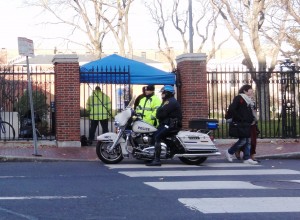






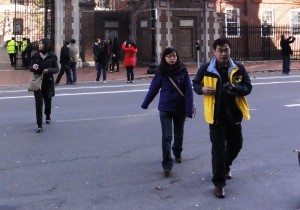


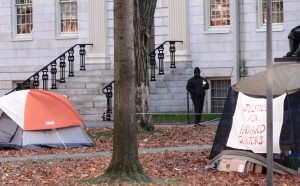

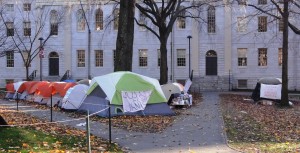


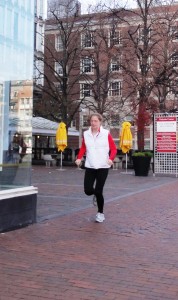
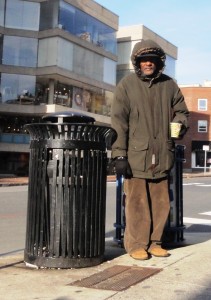





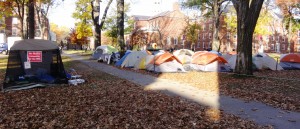

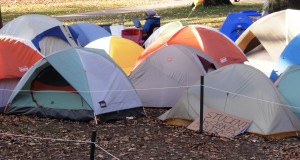





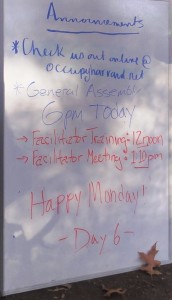




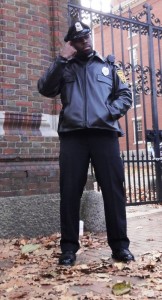


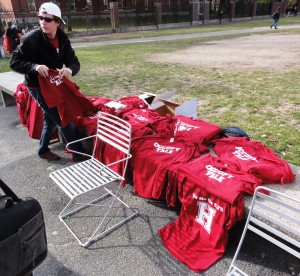




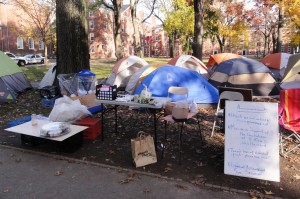







 Entries (RSS)
Entries (RSS)